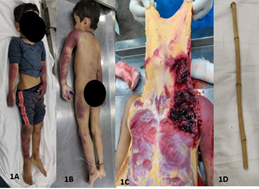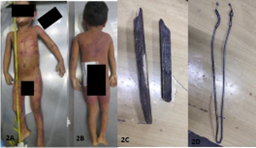AUCTORES
Globalize your Research
Case Report | DOI: https://doi.org/10.31579/2690-8808/138
Senior Resident, Department of Forensic Medicine and Toxicology, All India Institute of Medical Sciences (AIIMS), New Delhi, India.
*Corresponding Author: Venkatesh Janarthanan, Senior Resident, Department of Forensic Medicine and Toxicology, All India Institute of Medical Sciences (AIIMS), New Delhi, India.110029
Citation: Manivel S, Venkatesh Janarthanan, Aravindan V, M.D, Jay Narayan Pandit, Varun Chandran A, Sudhir K Gupta, Dr Abdul Raoof MP. (2022) Fatal Violent discipline in children – Two case reports, J. Clinical Case Reports and Studies: 3(7); DOI: 10.31579/2690-8808/138
Copyright: © 2022 Venkatesh Janarthanan, This is an open access article distributed under the Creative Commons Attribution License, which permits unrestricted use, distribution, and reproduction in any medium, provided the original work is properly cited.
Received: 12 July 2022 | Accepted: 23 July 2022 | Published: 03 August 2022
Keywords: violent discipline; child abuse; physical assault
A growing child attains psychological maturity and social skills while interacting with society. A supportive family and social environment will positively influence the child's development. Instead, children are experiencing various forms of abuse, violence, and cruelty. The authors report two such cases of children who were physically assaulted by their biological father and stepfather for disobedience, resulting in death. The autopsy surgeon should focus not only on the obvious external physical signs of violence but also on subtle or concealed signs in suspicious circumstances or incomplete and unreliable history provided by the parents. The article highlights the prevention of violence against children and the role of the autopsy Surgeon in detecting child abuse.
Discipline is training the individual to follow the rules and orders that help them know acceptable behaviors in appropriate situations [1]. It may vary in cultures, countries, and societies, like families, schools, and military camps. According to the Child discipline module by UNICEF, discipline is of two types, nonviolent and violent. Nonviolent discipline is clarifying a child by asking why the behavior was wrong, giving punishment to the child to do assignments, and taking them away from their fundamental rights. The violent discipline includes psychological aggression to a child, physical punishment like forceful shaking of a child, slapping of the face, ear, and head, spanking, and ear pinching. It also includes severe forms of punishment like scalding, burning, and beating with a stick and belt [2]. In domestic backgrounds, parents attempt to teach correct things to their children that may rarely end up with an unexpected fatality [3]. The authors report two such cases of children who were physically assaulted by their biological father and stepfather for disobedience, resulting in death. The article mainly highlights the prevention of violence against children and the role of the autopsy Surgeon in detecting child abuse.
Two such physical assault cases due to violent discipline were brought for postmortem examination to the Department of Forensic Medicine and Toxicology, All India Institute of Medical Sciences (AIIMS), New Delhi.
Case no. 1
A five-year-old male child was brought to casualty by his mother in an unconscious, unresponsive state with multiple bruises (Fig. 1A) all over the body. The parents provided no information to the attending doctor about the child's condition. The child was declared dead at casualty by the Emergency medical team.
On external examination, multiple tramline reddish contusions (Fig. 1B) of sizes ranging from 7cm x 0.5cm to 3.5 x 1.5cm were present over the entire body with an intervening intact area of the width of 2 cm. Multiple curvilinear scratch abrasions of sizes ranging from 1.2 cm x 0.2 cm to 1.5 cm x 0.5 cm are present over the right front-lateral aspect of the neck. An internal examination revealed that extravasation in soft tissues and musculature was present at the sites of tramline contusions (Fig. 1C). Patchy areas of Sub scalp contusion and peri cranial hemorrhages were present in the bilateral frontoparietal region. All internal organs were pale.
The alleged weapon of offense (bamboo stick) was produced for examination (Fig. 1D). Injuries found on the body matched the causative alleged bamboo stick. All injuries found on the body were antemortem in nature and fresh in duration. Therefore, the cause of death was opined as shock and hemorrhage due to multiple blunt force injuries sustained with a bamboo stick. Later, the police investigation revealed that the child was physically assaulted by his father.

Case no.2
A 5-year-old male child was brought to the hospital by his parents in an unresponsive state, with a history of seizures. On examination, his blood pressure, pulse, and other vital signs were nonrecordable, and he was declared dead.
On external examination, multiple injuries of different ages were present over the body. Multiple patterned reddish parallel abraded contusions intersecting at one end present over the face, neck, front and back of chest and abdomen, and both sides of upper and lower limbs. Multiple reddish tramline contusions were present over the bilateral gluteal and back thigh regions (Fig. 2A & 2B). Multiple contused lacerations were present over the inner aspect of the upper and lower lips. Blackish scabbed abrasions were present over the body at various places, and hypo-pigmented scars were present over the right side of the forehead and left shoulder. An internal examination revealed that extravasation of soft tissues and musculature was present at the sites of contusions. Patchy areas of sub-scalp bruises were present in places. Patchy subdural and subarachnoid hemorrhages were present over the cerebral hemisphere and the brain edema.
All intra-thoracic and intra-abdominal organs were intact and normal. A broken wooden stick (Fig. 2C) and a metallic spring wire (Fig. 2D) were produced for examination. The alleged weapons possibly made injury patterns found on the body. All injuries found on the body were antemortem and of different ages. The cause of death was opined as shock and hemorrhage due to multiple blunt force injuries sustained to the head, chest, abdomen, and limbs.

Children are the most vulnerable to violence by family members. The main reasons behind this are population overgrowth, poverty, unemployment, illiteracy, and the current economic crisis that makes children victimized in society. Some forms of violence against children are child labor, child marriage, physical and psychological abuse, neglect, exploitation, and sex trafficking. According to World Health Organization (WHO), one billion children aged 2–17 years experienced physical, sexual, or emotional violence in 2019, increasing yearly [3]. Over 2 lakh children aged less than 14 years were victimized by homicide during 2008–2017, as reported by United Nations Office on Drugs and Crime (UNODC) [4].
According to the National Society for the Prevention of Cruelty to Children (NSPCC) statistical briefing on child deaths due to abuse or neglect in the U.K., an average of at least one child was killed by assault in a week. In most cases, the perpetrators are the child's biological or stepparents. In England alone, 17 % of child homicides were caused by maltreatment within the family in the year 2020 [4]. In the United States, expanded homicide data released by the U.S. Department of Justice reported 13927 homicidal cases in 2019, of which 10.38% of cases victims were under 18 years of age [5]. National Crime Record Bureau (NCRB) of India shows that out of 30183 homicidal cases, 5.2% were below 18 years of age in 2020 [6].
Our case reports show apparent signs of physical violence, which are identifiable in the autopsy and suggestive of homicide. There are few case reports by other authors which show concealed findings that should not be missed in medicolegal autopsy. Ross E. et al. reported a case of a six-year-old boy who was forced by his foster father to consume an excess amount of Morton's Lite Salt (which contains an equal amount of potassium chloride and sodium chloride, a substitute to common table salt,) as punishment for misbehavior. The child developed convulsions and died during unsuccessful resuscitation. Postmortem examinations revealed a high vitreous potassium level, much higher than the average postmortem rise. The cause of death was hyperkalemia-induced cardiac arrhythmia. The foster father was later convicted [7].
Allen I. et al. reported a case series of three prepubertal children who were forced to drink around 6 L of water as punishment, one of them by a foster mother. The children developed convulsions and coma and died during the initial treatment period. Postmortem examinations revealed signs of physical abuse, which was not shown during the antemortem treatment period. Later subsequent investigations disclosed the fact, and the people who abused the children were penalized [8].
Steyn M conducted a second autopsy on the skeletal remains of 3.5 years old male child after 1.5 years of the primary autopsy. On the first autopsy, multiple bruises, lacerations, and head injuries with skull fractures were found, which were allegedly caused due to fall followed by a seizure attack. The subsequent autopsy revealed subperiosteal new bone growth at places, healing activity in the skull at sites other than the fracture site, and multiple untreated dental carries. All these findings disclosed chronic physical abuse of the child. The child's stepfather was convicted for chronic maltreatment and murder [9].
In both of our cases, detailed history was not provided to the treating doctors because the perpetrators were their parents or stepparents who tried to escape the crime. In these types of cases, due to less survival time, neglect by family members, and high fatality, there is no chance of clinical evaluation and diagnosis. However, in our cases, the postmortem examination revealed that the exact pattern of injuries gives a clue for the causative weapon, manner of injuries, and different aged injuries in case no.2, suggestive of chronic abuse.
Parents think that corporal punishment is the only last option to control children's negative behaviors, but it should not be to the extent that it endangers their lives. A growing child's environment should be a positive and supportive one that promotes inclusive growth of the child in education, personality, skill, and knowledge development to build a prosperous future generation. Therefore, the autopsy surgeon should focus not only on the obvious physical signs of violence but also on subtle or concealed signs of violence in suspicious circumstances or in incomplete and unreliable history provided by the parents.
Nil.
Nil.